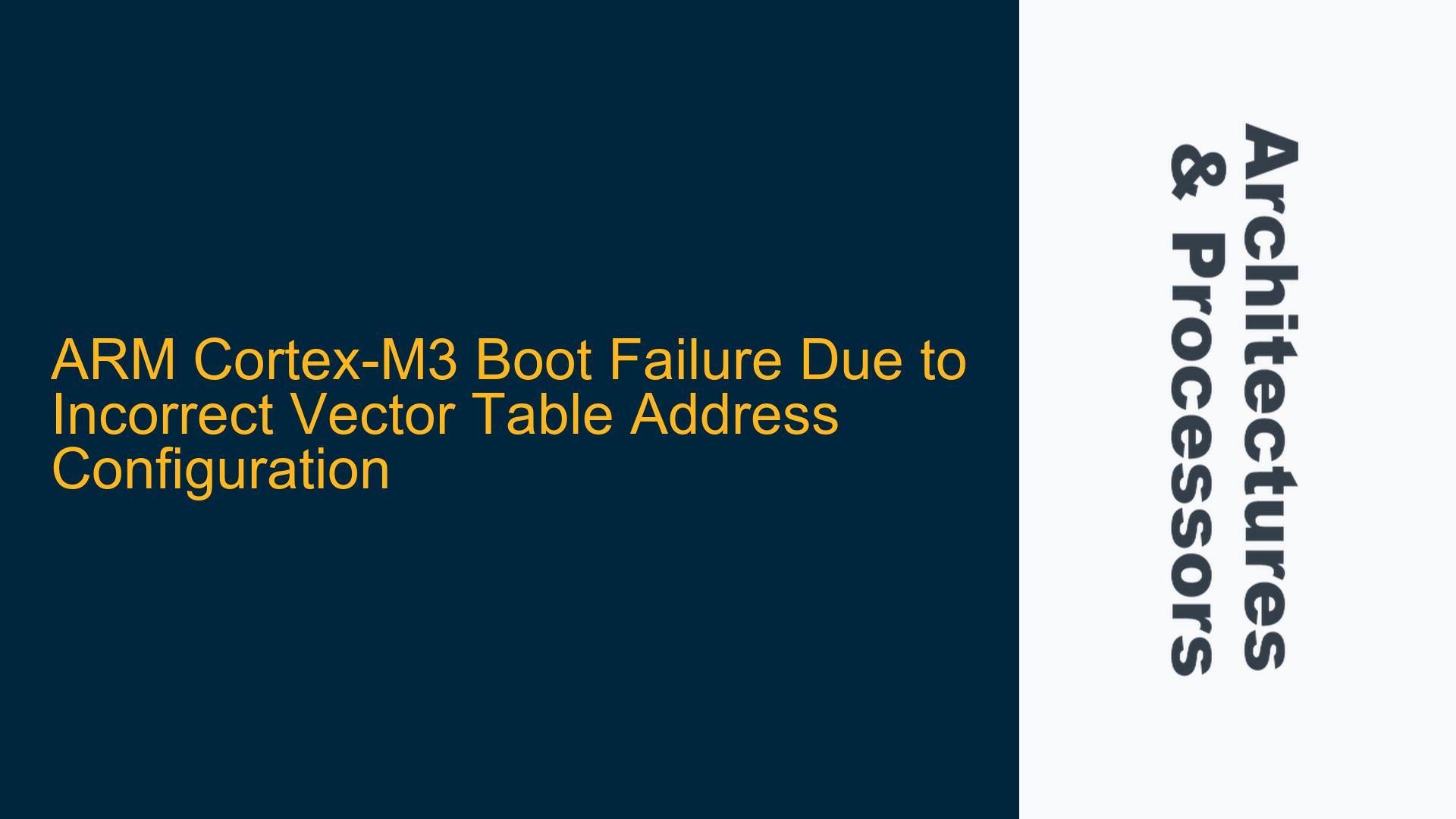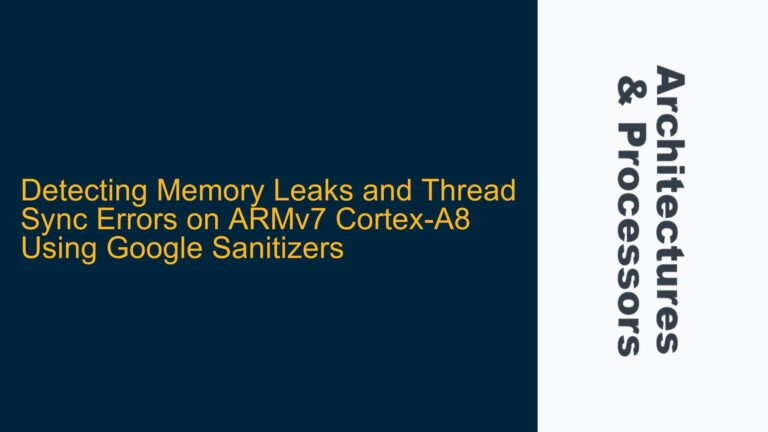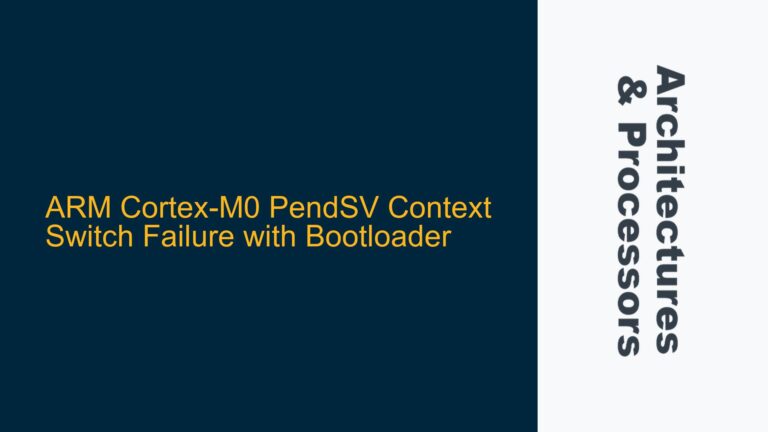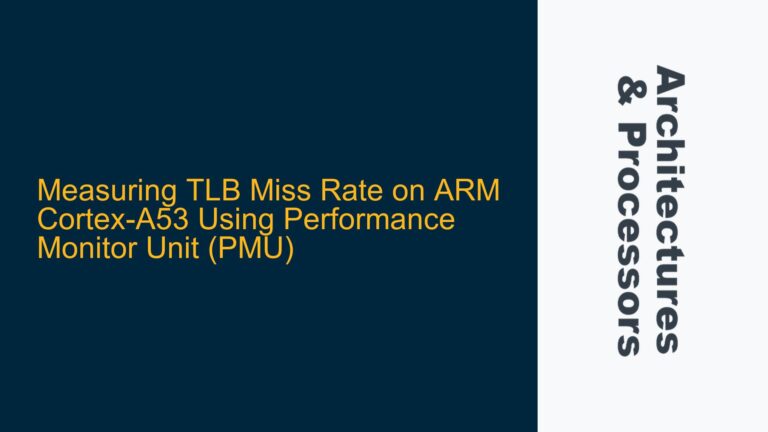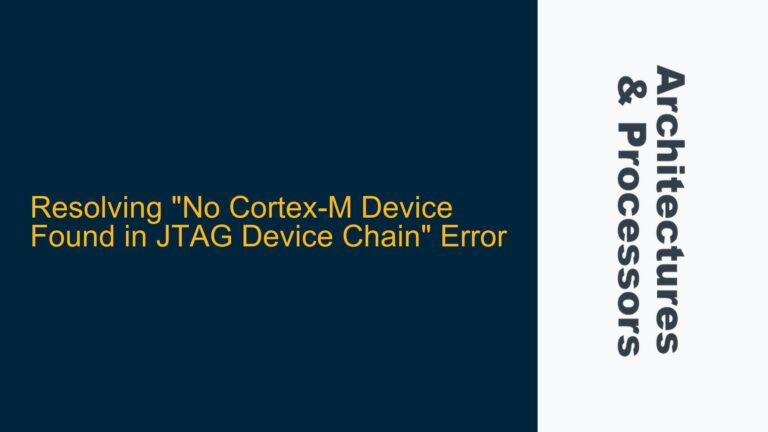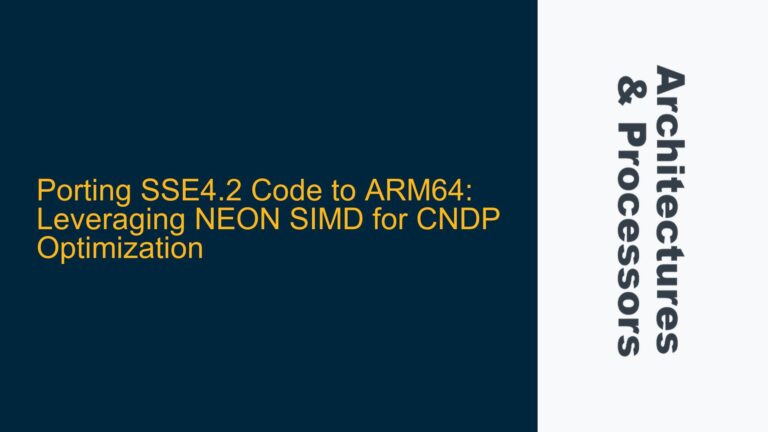Cortex-M3 Vector Table Initialization and Memory Map Constraints
The ARM Cortex-M3 processor, like other Cortex-M series processors, relies on a predefined memory map and a fixed initial vector table address to ensure proper boot-up and execution of firmware. The vector table is a critical data structure that contains the initial stack pointer value and the addresses of exception handlers, including the reset handler. For the Cortex-M3, the initial vector table address is fixed at 0x00000000. This means that upon reset, the processor fetches the initial stack pointer and the reset handler address from this location. Any deviation from this configuration, such as attempting to place the vector table at a different address, will result in a boot failure.
The Cortex-M3 memory map is divided into several regions, each with a specific purpose. The Code region (0x00000000 to 0x1FFFFFFF) is intended for executable code and the vector table. The SRAM region (0x20000000 to 0x3FFFFFFF) is used for data storage, while the Peripheral region (0x40000000 to 0x5FFFFFFF) is reserved for memory-mapped peripherals. Attempting to place executable code or the vector table in the Peripheral region will lead to undefined behavior, as this region is not designed to store executable code.
In the case described, the user attempted to load the firmware at 0x40000000, which falls within the Peripheral region. This is not permissible, as the Cortex-M3 processor expects the vector table to be located at 0x00000000. The result is a boot failure, as the processor cannot fetch the necessary initialization data from the correct location.
Misconfiguration of Linker Script and Startup Code
The root cause of the issue lies in the misconfiguration of the linker script and the startup code. The linker script is responsible for defining the memory layout of the firmware, including the placement of the vector table, code, and data sections. In this case, the linker script was configured to place the firmware at 0x40000000, which is incorrect for the Cortex-M3. The startup code, which is responsible for initializing the processor and setting up the runtime environment, must also be aware of the correct memory layout.
The startup code typically includes the vector table, which must be placed at the correct address (0x00000000 for Cortex-M3). If the vector table is not placed at the correct address, the processor will not be able to initialize properly, leading to a boot failure. Additionally, the startup code may include initialization routines for setting up the stack, configuring the clock system, and enabling interrupts. These routines must also be aware of the correct memory layout to function properly.
The user’s attempt to modify the --ro-base option in the linker command to 0x40000000 is a clear indication of this misconfiguration. The --ro-base option specifies the base address for the Read-Only (RO) section of the firmware, which includes the vector table and executable code. For the Cortex-M3, this must be set to 0x00000000 to ensure that the vector table is placed at the correct address.
Correcting the Linker Script and Startup Code for Proper Boot
To resolve the issue, the linker script and startup code must be corrected to ensure that the vector table and executable code are placed at the correct addresses. The following steps outline the necessary corrections:
-
Linker Script Configuration: The linker script must be modified to place the vector table and executable code at the correct address (0x00000000 for Cortex-M3). This can be achieved by setting the
--ro-baseoption to 0x00000000 in the linker command. The linker script should also define the memory regions correctly, ensuring that the Code region is mapped to 0x00000000 and the SRAM region is mapped to 0x20000000. -
Startup Code Placement: The startup code, including the vector table, must be placed at the correct address (0x00000000). This can be achieved by ensuring that the startup code is included in the RO section of the firmware and that the vector table is correctly defined. The vector table should include the initial stack pointer value and the address of the reset handler, as well as the addresses of other exception handlers.
-
Memory Map Awareness: The startup code must be aware of the Cortex-M3 memory map and ensure that all initialization routines are configured to use the correct memory regions. This includes setting up the stack pointer, configuring the clock system, and enabling interrupts. The startup code should also ensure that any data sections are placed in the correct memory region (SRAM).
-
Testing and Validation: After making the necessary corrections, the firmware should be tested to ensure that it boots correctly and executes as expected. This can be done using a debugger to step through the startup code and verify that the vector table is correctly placed and that the processor initializes properly.
By following these steps, the issue of boot failure due to incorrect vector table address configuration can be resolved. It is important to note that the Cortex-M3 processor has a fixed initial vector table address, and any deviation from this configuration will result in a boot failure. Therefore, it is crucial to ensure that the linker script and startup code are correctly configured to place the vector table and executable code at the correct addresses.
Detailed Explanation of Cortex-M3 Memory Map and Vector Table
To further understand the issue, it is important to delve deeper into the Cortex-M3 memory map and the role of the vector table in the boot process. The Cortex-M3 memory map is divided into several regions, each with a specific purpose:
| Memory Region | Address Range | Purpose |
|---|---|---|
| Code | 0x00000000 – 0x1FFFFFFF | Executable code and vector table |
| SRAM | 0x20000000 – 0x3FFFFFFF | Data storage (stack, heap, and global variables) |
| Peripheral | 0x40000000 – 0x5FFFFFFF | Memory-mapped peripherals |
| External RAM | 0x60000000 – 0x9FFFFFFF | External memory (if available) |
| External Device | 0xA0000000 – 0xDFFFFFFF | External devices (if available) |
| System | 0xE0000000 – 0xFFFFFFFF | System control and debug components |
The vector table is a critical component of the Cortex-M3 boot process. It is an array of addresses that the processor uses to initialize the stack pointer and to handle exceptions. The first entry in the vector table is the initial stack pointer value, and the second entry is the address of the reset handler. The remaining entries are the addresses of other exception handlers, such as the NMI handler, hard fault handler, and interrupt handlers.
The vector table must be placed at the correct address (0x00000000 for Cortex-M3) to ensure that the processor can fetch the necessary initialization data. If the vector table is not placed at the correct address, the processor will not be able to initialize properly, leading to a boot failure.
Example of Correct Linker Script and Startup Code Configuration
To illustrate the correct configuration, consider the following example of a linker script and startup code for a Cortex-M3 processor:
Linker Script (linker.ld):
MEMORY
{
FLASH (rx) : ORIGIN = 0x00000000, LENGTH = 512K
SRAM (rwx) : ORIGIN = 0x20000000, LENGTH = 64K
}
SECTIONS
{
.text :
{
*(.vector_table)
*(.text*)
*(.rodata*)
} > FLASH
.data :
{
*(.data*)
} > SRAM AT > FLASH
.bss :
{
*(.bss*)
} > SRAM
}
Startup Code (startup.c):
#include <stdint.h>
extern uint32_t _estack;
extern int main(void);
void Reset_Handler(void);
void Default_Handler(void) { while(1); }
__attribute__((section(".vector_table")))
uint32_t *isr_vectors[] = {
&_estack, // Initial stack pointer
(uint32_t *)Reset_Handler, // Reset handler
(uint32_t *)Default_Handler, // NMI handler
(uint32_t *)Default_Handler, // Hard fault handler
// Other exception handlers...
};
void Reset_Handler(void) {
// Copy data section from FLASH to SRAM
uint32_t *src = &_etext;
uint32_t *dst = &_sdata;
while (dst < &_edata) {
*dst++ = *src++;
}
// Zero initialize the BSS section
dst = &_sbss;
while (dst < &_ebss) {
*dst++ = 0;
}
// Call the main function
main();
}
In this example, the linker script correctly places the vector table and executable code in the FLASH memory region starting at 0x00000000. The startup code defines the vector table and includes the necessary initialization routines to copy the data section from FLASH to SRAM and to zero initialize the BSS section. The reset handler then calls the main function, which is the entry point of the application.
Conclusion
The issue of boot failure in the Cortex-M3 processor due to incorrect vector table address configuration is a common pitfall for developers new to the ARM architecture. By understanding the Cortex-M3 memory map and the role of the vector table in the boot process, developers can avoid this issue by correctly configuring the linker script and startup code. The key takeaway is that the vector table must be placed at the correct address (0x00000000 for Cortex-M3) to ensure proper boot-up and execution of firmware. By following the steps outlined in this guide, developers can ensure that their Cortex-M3-based systems boot correctly and execute as expected.
